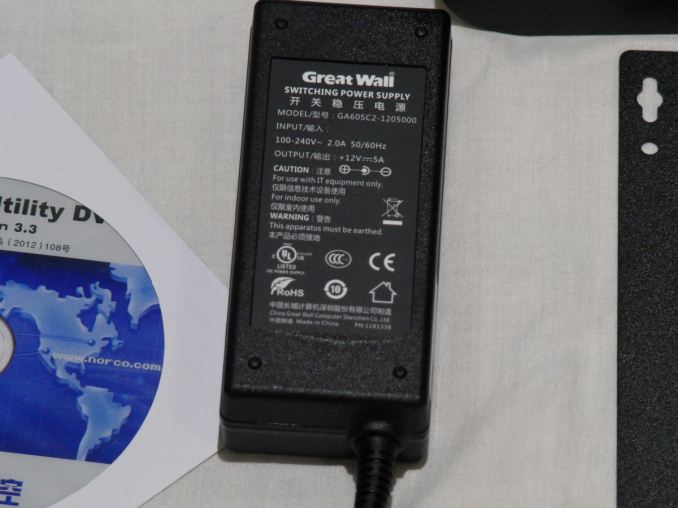HABEY BIS-6922 Fanless Ivy Bridge Industrial PC Review
by Ganesh T S on August 13, 2013 9:00 AM EST- Posted in
- Industrial PC
- Ivy Bridge
- Passive Cooling
- Habey
Concluding Remarks
Passively cooled high performance PCs are not easy to design and bring to the market. Creating a dust-proof enclosure is also a big challenge. By successfully rising up to these two challenges, Habey manages to hit a home run with the BIS-6922. The choice of chipset and processor as well as the design of the motherboard lend themselves well to the target market. In terms of the performance of the review unit, we would have liked to see DDR3-1600 SODIMM, considering that the Ivy Bridge platform supports it officially. A SSD with higher performance wouldn't have hurt either.
The review unit was not without its problems, though. The power brick (Great Wall brand) bundled with the unit was rated for 60W DC output. Full loading of the unit drew close to 67W. Habey indicated that they don't expect consumers to fully load both the CPU and GPU and stress the power adapter to that extent. We found that the power brick also developed a very audible whine after prolonged use at medium loads. Habey later sent us a 100W power brick (a no-name Chinese OEM model) as replacement and it doesn't seem to be suffering from the whine issue as yet.
The nice aspect about Habey's BIS-6922 is the ability for consumers to customize the components extensively. Components of a particular brand / model can be requested, be it for the DRAM or the SSD or the PSU. I strongly recommend prospective customers to request a power brick from a reputable manufacturer while configuring the system (Seasonic and Delta Electronics come to mind as adapters that have held up well in our labs). Unlike most other manufacturers, Habey doesn't sell units off-the-shelf. Due to the extent of customization that most of the target market requires, an inquiry needs to be placed on their website in order to initiate a purchase order.
In conclusion, the BIS-6922 is the most powerful and efficient passively cooled PC in the mini-ITX form factor that we have seen. Other than the fact that the end user needs to be a bit careful in selecting some of the components, we have little to complain about.











63 Comments
View All Comments
ganeshts - Tuesday, August 13, 2013 - link
Definitely not throttling, but I guess the discrepancy is that Habey locks the frequency to 2.6 GHz (Turbo disabled by default, which is what I tested). Maybe your 3630QM is not Turbo-locked in the BIOS.I was keeping track of the CPU freq all through the benchmark programs and also during the 18-hours stress test.
whyso - Tuesday, August 13, 2013 - link
Ah, nice. (It would really be nice if when a result is below normal we got to see the CPU frequency).Still weird why they would pay extra for the 3720 and then disable turbo compared to simply using a cheaper 3630/3610 or even the 35 watt 3612 with turbo.
ganeshts - Tuesday, August 13, 2013 - link
You can go to the BIOS and unlock Turbo, as long as you are confident about the ambient conditions as well as how much you are going to stress the unit.From our testing, we can guarantee it will thermally hold up for full load at 76 F with the CPU at 2.6 GHz and GPU at 1.125 GHz.
airmantharp - Tuesday, August 13, 2013 - link
I'd think that Turbo would be useful if the system were in a ventilated environment or wasn't subjected to sustained loads, from a race-to-idle perspective. I do understand the reasoning behind leaving it off by default, though, as it prevents wild swings in performance due to throttling after Turbo.ervinshiznit - Tuesday, August 13, 2013 - link
On the power consumption and thermal performance page, it is stated that it is throttling."One of the unfortunate aspects of the Aleutia Relia was that the unit ended up getting throttled when subject to heavy loading even at room temperature (72 F)."
owan - Tuesday, August 13, 2013 - link
That as a different unit that they had tested earlierSlomo4shO - Tuesday, August 13, 2013 - link
So a laptop converted into a desktop?vision33r - Tuesday, August 13, 2013 - link
More like a desktop shrunken down. With laptop components the system should run much cooler and tinier.thesavvymage - Tuesday, August 13, 2013 - link
it does have laptop components... the QM in the processor model designates Quad core Mobile.rob_allshouse - Tuesday, August 13, 2013 - link
Why a CD vs a USB? I've had to make one of these decisions recently. $0.12 vs $2-3, on something people just use the internet for anyway. The customer really doesn't want to pay an extra $3 for something that 99% of them don't use.